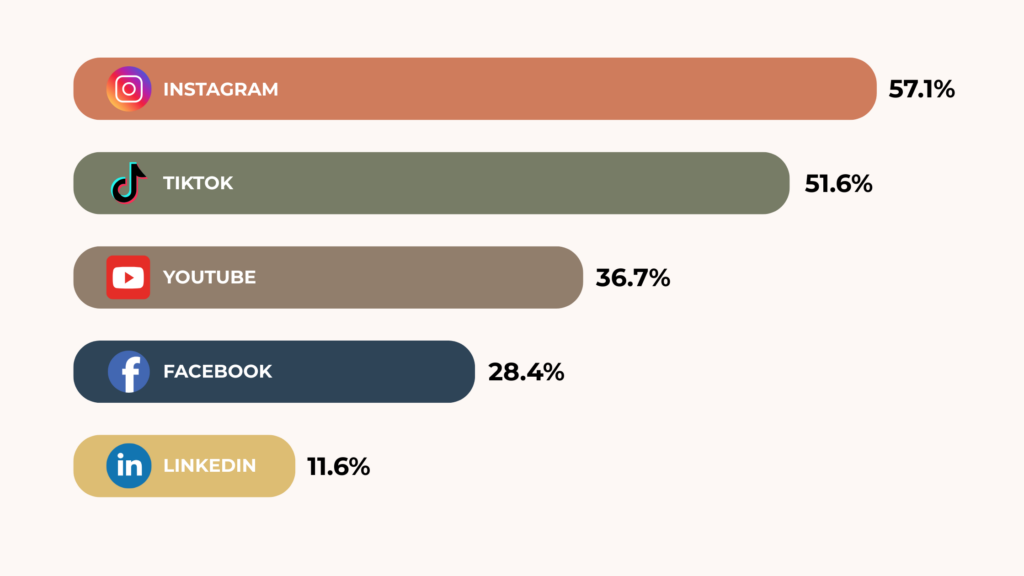I remember the days when creating content wasn’t seen as a serious career or a “real job.” The Creator Economy has certainly come a long way after receiving a good amount of those comments over my 8+ year career. Today, content creation has expanded vastly, and it’s quickly replacing traditional marketing and advertising as we know it. This is good news for aspiring content creators of all sizes and levels. If you’re ready to start navigating the ever-evolving landscape of the Creator Economy in 2025, you’re in the right place. The Creator Economy has become a powerhouse with a market projected to reach $528.39 billion by 2030.
Whether you’re just starting out or looking to scale your content creation business, understanding what brands are paying for, how to position yourself as a hireable and desirable creator, and the overall state of the creator economy is key to your success. Here are 8 key statistics about the Creator Economy in 2025 that every content creator should know, along with actionable insights to help you thrive.

1. The Creator Economy’s Explosive Growth
The Creator Economy is on a meteoric rise, with projections estimating it will reach $528.39 billion by 2030. This growth is fueled by the increasing demand for authentic content and the diversification of monetization avenues for creators. It’s also reflected by the number of content creators there are globally. According to LinkTree’s 2022 data, there are 207 million content creators who create content across various platforms consistently. And from that number, 45 million of them are professional content creators. In 2025, the options for creators have expanded to include platforms like Substack and BlueSky – increasing the number of creators across the board.
What this means for you: While you might be overwhelmed by the sheer number of creators out there, only a handful of creators know how to navigate this growing arena. Equipping yourself with the information and knowledge that’ll help you position yourself in a favorable light with both audiences and brands alike will help keep you above the noise.
2. TikTok’s Dominance in Influencer Marketing
In recent years, TikTok has solidified its position as a go-to platform for influencer marketing. With 69% of brands turning to it for campaigns, there’s no doubt that its discovery-style algorithm is a powerful marketing tool. With that being said, the threat of a TikTok ban in the US is still looming over content creators and brands alike. So while reports claim to see a dip in Instagram usage, it still outranks TikTok as the preferred platform for influencer campaigns. Here’s the statistics of preferred channels for influencer campaigns in the Creator Economy:

Even with this information, the full context of the situation can be better understood by looking at the year-over-year platform changes from 2024 to 2025:
- Instagram: Compared to 2024, Instagram has seen a growth of +0.5%. It might seem small, but it just emphasizes the platform’s dominance over the Creator Economy, even with TikTok’s rise.
- TikTok: While brands are flocking to TikTok more than ever, it saw a decline of -17.2% in 2025 compared to 2024. This could be due to the fallout of the US TikTok ban.
- YouTube: YouTube’s growth has been consistent, seeing +0.7% growth in 2025. This means long-form, in-depth content is still here to stay.
What This Means for You: Don’t get distracted by shiny object syndrome. While it might feel like TikTok is where all the action is at, older platforms like Instagram and YouTube are tried-and-true. They’re reliable and consistent.
3. The Rise of Micro and Nano-Influencers
I know, I know… every influencer coach out there is telling you that brands are turning to nano and micro-influencers now more than ever. You might have heard it so much that your alarm bells go off, thinking it is some marketing ploy to coax you into signing up for their program. But I promise, that isn’t the case. And today I’m delivering on the proof. Micro (10,000–100,000 followers) and nano-influencers (1,000–10,000 followers) account for 26% and 44% of brand partnerships, respectively. These influencers often boast higher engagement rates and more niche audiences.
This continuous shift towards nano and micro-influencers reflects the power of a hyper-focused, smaller audience with higher engagement and deeper connection. This isn’t just the most cost-effective partnership for brands, but it also produces a worthwhile ROI (return on investment).
What This Means for You: Don’t let your audience size stop you from pitching brand partnerships. With emerging opportunities through UGC and EGC (employee-generated content), brands recognize the value of authentic, skilled, and well-crafted content. The size of your following is far from what brands actually hire creators for. If you’re a micro or nano-influencer, highlight your engagement metrics and niche audience when pitching to brands. Your ability to connect authentically with your followers is a valuable asset.
4. AI’s Integration into Influencer Marketing
Artificial Intelligence isn’t just transforming influencer marketing, it’s changing the way we do business. According to this benchmark report, 63% of brands plan to incorporate AI into their campaigns. But they’re not using it in the way you think. It’s easy to give in to the AI panic by thinking that it’ll replace the need for content creators, but that couldn’t be further from the truth. Instead, brands are using AI for influencer discovery, content optimization, and performance analysis.
The main usage of AI? To vet audience authenticity and inflated engagement.
What This Means for You: AI can be a powerful tool for you as a content creator, but it is not a replacement for you. Use it to analyze your content performance and audience demographics so that you can tailor and optimize your content as you continue on your journey. I’ve got a blog post about the right ways to use AI to power your content process, so check that out and leverage it in your favor.
5. Employee-Generated Content is Entering the Chat
You’ve heard about UGC (user-generated content), but do you know about EGC (employee-generated content)? In case this is news to you, brands are expanding their repertoire of content by hiring in-house content creators. On top of social media managers, UGC, and influencer collaborations, companies are adding EGC to fortify their marketing strategies. These in-house content creators get paid an average of $7k to $10k a month to be a full-time content creator for the brand. This further highlights the importance of authentic, everyday content. Here are the stats to back that up:
- 50% of social media/video platform users are looking for content that “mirrors their lives”
- 88% of consumers say that authenticity is an important factor in deciding which brands they support
- 57% of consumers will increase their spending with brands they feel connected to
- 76% of consumers will buy from brands that accomplish that over their competitors
What This Means for You: While there isn’t a degree requirement for EGC roles, having experience as an influencer or UGC creator is a must. After all, you need to prove the efficacy of your work through a portfolio.
6. Consumer Trust in Influencer Recommendations
Approximately 69% of consumers trust influencer recommendations, highlighting the persuasive power of authentic content. This trust translates into purchasing decisions and brand loyalty, making front-facing influencers and content creators an invaluable asset to brands.
What This Means for You: Maintain transparency and authenticity in your content. In my G.A.I.N. Framework, I talk about making “income” style content so that a paid partnership feels natural to your audience. And when you do land a paid partnership, be sure to disclose it accordingly and only promote products you genuinely endorse to preserve and build trust with your audience.
7. Platform Diversification Amid Uncertainties
As I mentioned before, the state of TikTok is still uncertain in the US. This emphasizes the importance of diversification of platforms and income. This strategy mitigates risks associated with platform-specific dependencies. Whether you’re expanding to YouTube, a podcast, a newsletter, or Substack, diversification is a must if you want to build a sustainable, long-lasting career as a content creator.
What This Means for You: Expand your content distribution across multiple platforms like Instagram, YouTube, and emerging networks. This approach ensures continued reach and engagement regardless of platform-specific issues.
8. The Shift Towards Authenticity and Niche Content
Audiences are clearly gravitating towards content that feels genuine and relatable. Creators focusing on niche topics and authentic storytelling are seeing increased engagement and loyalty. All of which can be leveraged to increase your pay, regardless of your follower count.
What This Means for You: Don’t underestimate the importance of doubling down on your niche. This will be key to building a hyper-engaged and tight-knit audience.
Wrapping Up
The Creator Economy in 2025 presents immense opportunities for content creators who are adaptable, authentic, and data-savvy. By understanding these key statistics and implementing the actionable insights provided, you can position yourself for success in this dynamic landscape.
Remember, your unique voice and perspective are your greatest assets. Stay true to your brand, continuously learn, and embrace the tools and strategies that align with your goals. Here’s to your growth and success in the Creator Economy!

+ show Comments
- Hide Comments
add a comment